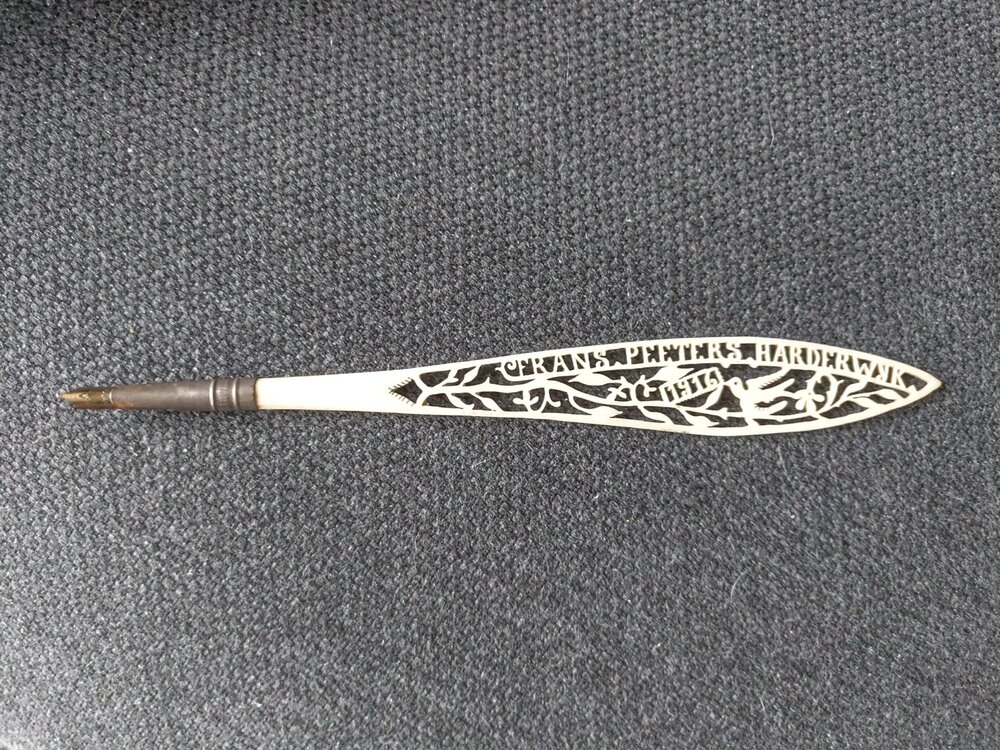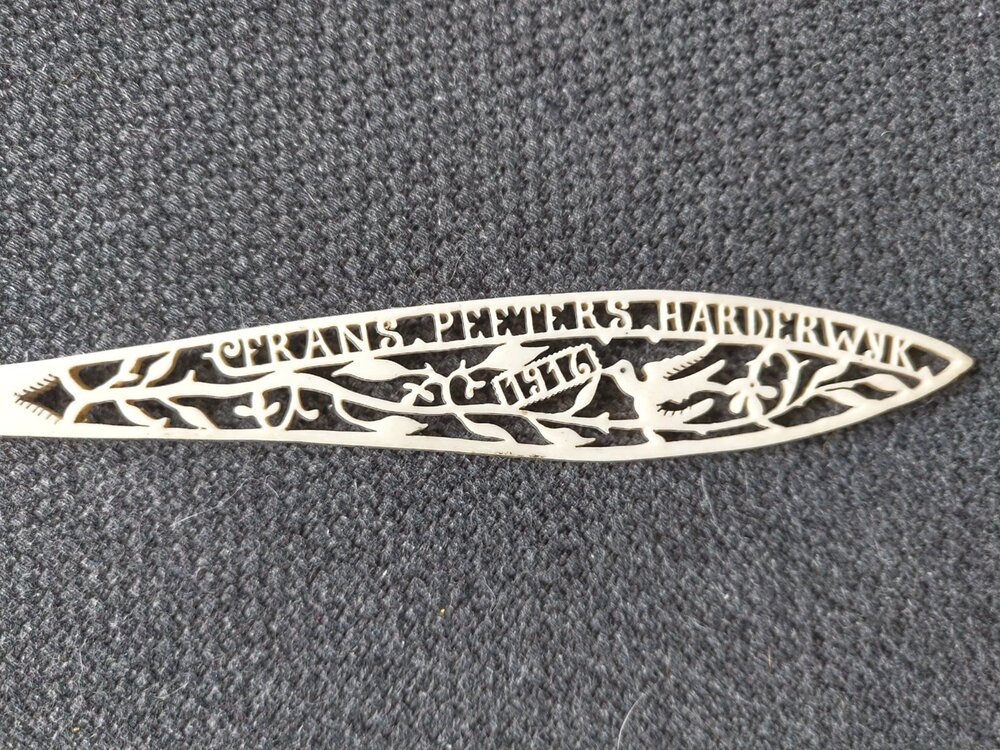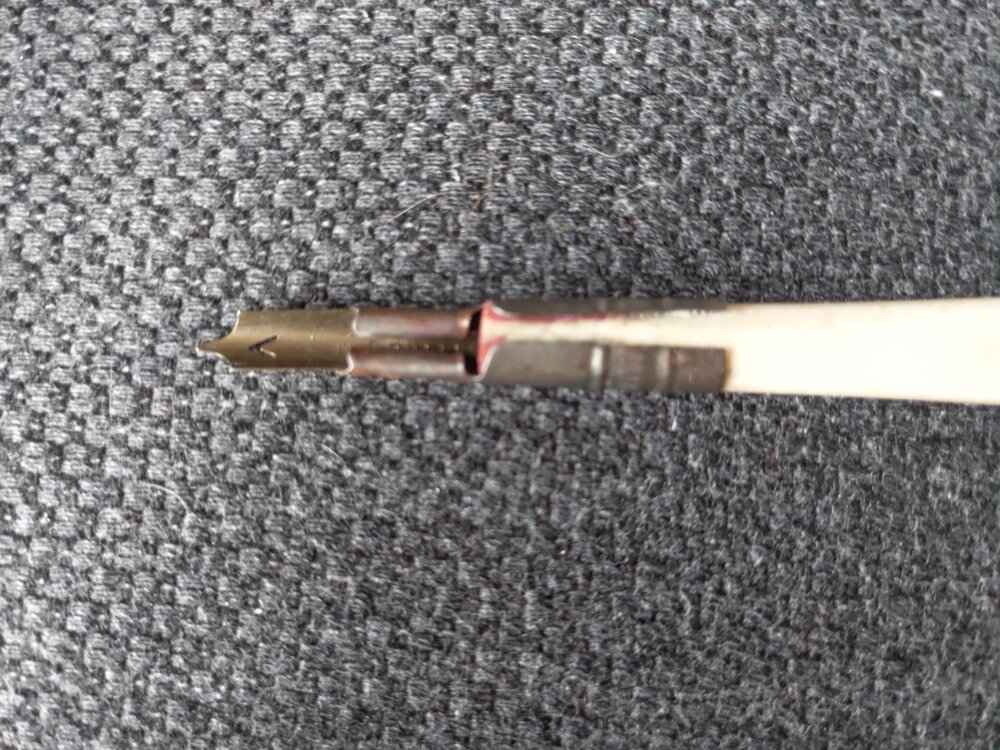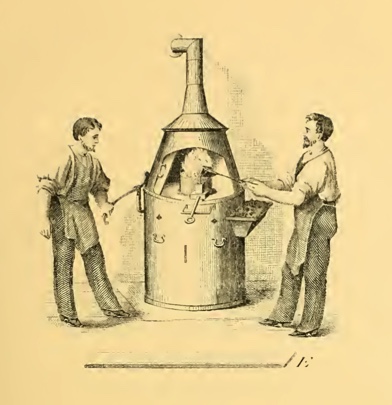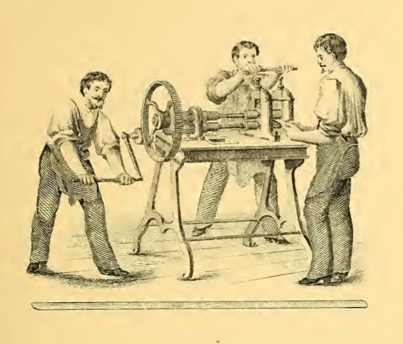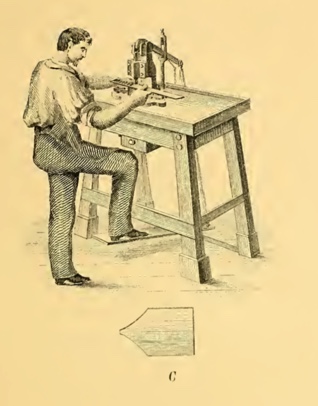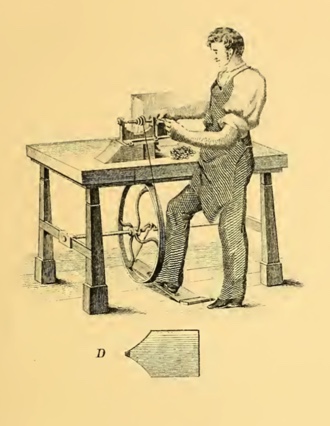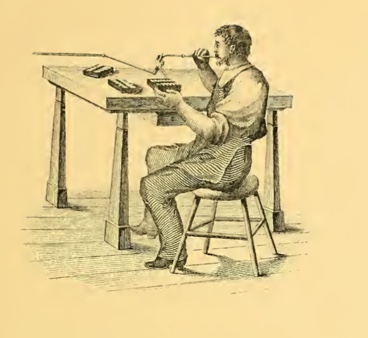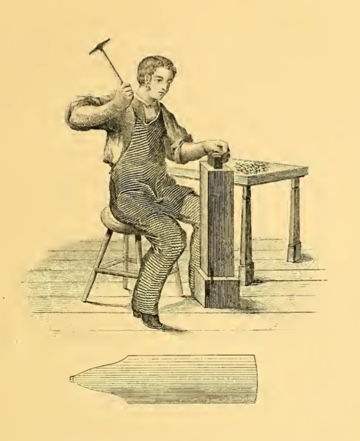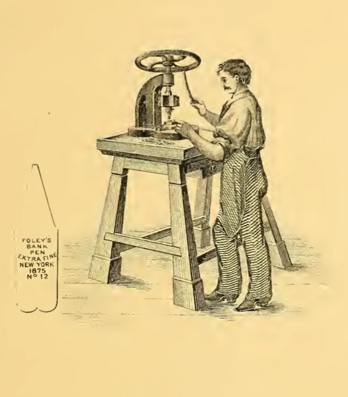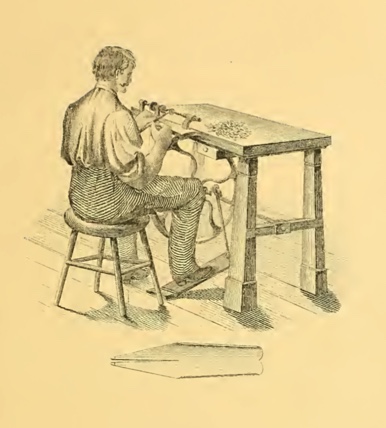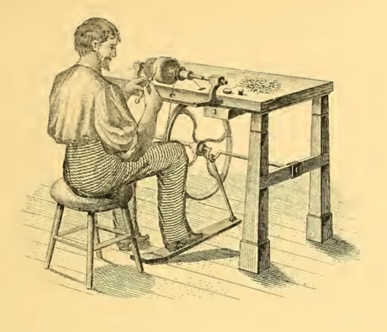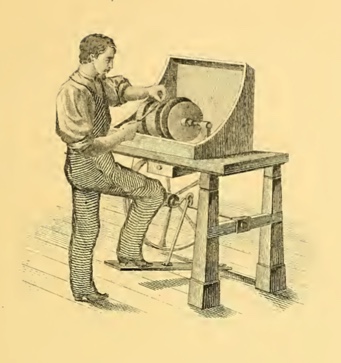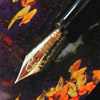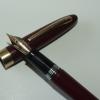Search the Community
Showing results for tags 'antique'.
-
Got this antique Montblanc pen as a gift a few days ago, was wondering exactly which model or series it is. The nib says Iridium point Germany on it, it was bought in an antique store in Istanbul. Thank you in advance, if any extra info is needed I can provide!
- 8 replies
-
- montblanc
- identification
-
(and 1 more)
Tagged with:
-
I once read a similar post about fountain pens on FPN. Since there are many dip pen users and collectors in FPN, I thought it would be interesting to know what is the oldest one in their possession. My humble collection consists of just three dip pen holders. One is a modern wooden straight holder and the other two are the oldest ones. I know this one is old but I couldn't figure out the exact time period. It's not very clear, but upon close inspection one can see "Calcutta" (old name of Kolkata, capital city of West Bengal state in India) imprinted on it. The second dip pen is much more dipped into history. It was gifted to me by one of my father's friend (in fact, the first one is also his gift). It belonged to his grandfather, Manoranjan Sengupta, who happened to be an Indian freedom fighter and a companion of the famous Indian revolutionary "Bagha" Jatin. (Here is the link of the Wikipedia page on Bagha Jatin. You will also find the name of Manoranjan Sengupta mentioned in the 'Death' section. https://en.m.wikipedia.org/wiki/Bagha_Jatin ) If Manoranjan Sengupta himself didn't inherit the holder from one of his predecessors then I think it might be from the early decades of 1900. I am not sure about the material of this pen. It feels somewhat like buffalo horn. Another possibility is laquer (must be hundreds of layers if it is really so) on wood. I am pretty proud of this holder. It thrills me when I hold it in my hand knowing that it was once used by a great man who sacrificed his life for the freedom of my nation. Now it's your to turn to tell me about the oldest dip pen in your collection.
-
1908 waterman checkbook cardinal worth sterling filigree
Hondabob posted a topic in Fountain & Dip Pens - First Stop
Looking for a value on this pen, looking to buy, just do not want to over pay and I am finding very little about it. Any help would be great. Thank you. It’s auction based sight -
Hello everyone 😊, greetings from the Netherlands! Happy to be here in the Fountain Pen Network 😁 I need your expertise. I've acquired this striking, antique personalized dip pen made of ivory from a reputable auction house. Aside from certifying the authenticity and legality of the item, they don't have information such as: Were pens like these made for military personnel, artists, medical staff at that time, etc? Were these given as an acknowledgement of a notable contribution or because of a special event? Was personalization of pens like these typical back then? I'm a complete novice on fountain pens and after hours of research, I couldn't find any leads. I just want to know the story behind it. I did find some Frans Peeters during that time period: one was a soldier, one was an artist and another one was a Belgian architect. I don't know if the any of them is the Frans Peeters I'm looking for. Perhaps it's best I approach a Dutch govt. body on public records. Any info would be greatly appreciated 🙏🏻
-
.thumb.jpg.fa47f5f051e847ecf4396ad6c7a7554f.jpg)
📌 Expertise needed: Rare antique European dip pen
Erika posted a topic in Fountain & Dip Pens - First Stop
Hello everyone 😊, greetings from the Netherlands! Happy to be here in the Fountain Pen Network 😁 I need your expertise. I've acquired this striking, antique personalized dip pen made of ivory from a reputable auction house. Aside from certifying the authenticity and legality of the item, they don't have information such as: Were pens like these made for military personnel, artists, medical staff at that time, etc? Were these given as an acknowledgement of a notable contribution or because of a special event? Was personalization of pens like these typical back then? I'm a complete novice on fountain pens and after hours of research, I couldn't find any leads. I just want to know the story behind it. I did find some Frans Peeters during that time period: one was a soldier, one was an artist and another one was a Belgian architect. I don't know if the any of them is the Frans Peeters I'm looking for. Perhaps it's best I approach a Dutch govt. body on public records. Any info would be greatly appreciated 🙏🏻 -
Hello everyone 😊, greetings from the Netherlands! Happy to be here in the Fountain Pen Network 😁 I need your expertise. I've acquired this striking, antique personalized dip pen made of ivory from a reputable auction house. Aside from certifying the authenticity and legality of the item, they don't have information such as: We're pens like these made for military personnel, artists, medical staff at that time, etc? Were these given as an acknowledgement of a notable contribution or because of a special event? Was personalization of pens like these typical back then? I'm a complete novice on fountain pens and after hours of research, I couldn't find any leads. I just want to know the story behind it. I did find some Frans Peeters during that time period: one was a soldier, one was an artist and another one was a Belgian architect. I don't know if the any of them is the Frans Peeters I'm looking for. Perhaps it's best I approach a Dutch govt. body on public records. Any info would be greatly appreciated 🙏🏻
-
Hello everyone 😊, greetings from the Netherlands! Happy to be here in the Fountain Pen Network 😁 I need your expertise. I've acquired this striking, antique personalized dip pen made of ivory from a reputable auction house. Aside from certifying the authenticity and legality of the item, they don't have information such as: Were pens like these made for military personnel, artists, medical staff at that time, etc? Were these given as an acknowledgement of a notable contribution or because of a special event? Was personalization of pens like these typical back then? I'm a complete novice on fountain pens and after hours of research, I couldn't find any leads. I just want to know the story behind it. I did find some Frans Peeters during that time period: one was a soldier, one was an artist and another one was a Belgian architect. I don't know if the any of them is the Frans Peeters I'm looking for. Perhaps it's best I approach a Dutch govt. body on public records. Any info would be greatly appreciated 🙏🏻
-
Hi all, Relatively new here.... Anyway, I have a few magic pencils which I assume are Victorian Era. For 2 of them, the sliding mechanism is stuck, meaning, the part you move up and down to produce the pencil won't move. I was hoping for some tips on repair for these, I've tried the normal ways, heat, oil and nothing seems to work, they are just stuck. Any help with this issue is greatly appreciated. Bret Battaglia
- 1 reply
-
- pencils
- magicpencils
-
(and 2 more)
Tagged with:
-
I'm not really sure where I should put this post, so please let me know if it's supposed to live somewhere else. I have decided that I want to go hunting for vintage flex. A little background information... (actually it turned out to be more than a little) I have 2 (useable) vintage fountain pens. A Conway Stewart Universal Pen from the late 1930s, and a Parker 51 Aerometric from the late 1950s. The majority of my 'flex' experience is in using dip pens, and I have been using them for journaling and the occasional attempt at everyday writing with them for the past 3 and a half-ish years, so I would say that I am reasonably experienced in the (?)art(?) of using flexible nibs. So why do I want to get a vintage flex pen? I have discovered (an odd century or 2 too late) that using dip pens, while extremely versatile, aren't exactly convenient, portable (one accident with a bottle of ink in my bag was enough to let me understand) nor very durable, with the untipped points soon wearing out. As such I believe that what would best suit me is an antique or vintage fountain pen. What I would like in the pen I am looking for: a very fine point (line variation of sorts needs to start somewhere) Preferably from the 1920s and earlier? I'm not going to be mashing it out to 2mm for every letter and downstroke so you can rest easy regarding spring the nib. If I wanted to mash my nibs I've got plenty of dip pens to do that. I'm (probably) not going to do calligraphy with them. Again, I have dip pens. Yet I still want a super flex/wet noodle/ whatever name you want to call it. but not to mash. I fine with doing a little bit of work on them if necessary eg, replacing a sac or a j-bar for lever fillers, oe cleaning them out or whatever) Now my question is: where do you recommend I actually go looking for these? Do I go on eBay? Do I go to antique shops (although to be honest most of the antique shops in my area probably won't have these as we didn't have companies that made these here. Most are probably old imports)? How much should my cut-off price point be? I don't want to be overcharged by sellers who know what they are doing, so what's a reasonable price? Please let me know your recommendations, tips and thoughts.
-
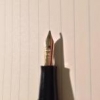
Making Gold Flex Nibs; From A Victorian Pen Catalogue
Lunoxmos posted a topic in Fountain & Dip Pens - First Stop
Credit given to David Armstrong from The Restorers Art Original article found here Copy of the catalogue found here Recently I came across a Victorian Era pen catalogue called the: "History of the invention and illustrated process of making Foley's diamond pointed gold pens" It starts off with a catalogue of the various products that the company offered, such as gold dip pens, and mechanical pencils, along with other bizarre combinations such as an instrument with a toothpick on one end and an ear spoon on the other. The main interest of the document, however, is that in the second half it details the history of the development of the Gold pen (or nib, as we would say these days), as well as the process in how these pens were made. After reading the catalogue myself, I along with David Armstrong and probably many other people as well, have concluded that the level of modern nib manufacturing is, though in my opinion, not exactly plagued by poor workmanship (a good nail nib is still a good nail nib), but has instead become complacent, perhaps unaware of the potential profits which could be obtained from the enthusiastic, albeit rather niche consumer group. (have a look at some of the prices that vintage flex fetches on eBay!) We have not really lost the technology or the method of producing flexible gold nibs. If you read the below copy-and-paste of the text, you can see that the only thing that was required to make the gold "flexible" was to hammer it; something that I believe with a little bit of will and determination we can replicate in a mechanical form, using machinery instead of a blacksmith, to make each one as precisely and accurately manufactured as the one before. "The nib of each Pen, as shown above, is hammered on a small anvil or stake, of curved surface, until the required spring or elasticity is secured, so that the nib of the Pen will bend almost double and again return to its proper position." Of course there are many things in the detailed process which can be automated due to our large advances in technology. For example, I believe that we have improved our tipping process, compared to when the Victorians were still figuring it out. Much of the tipping of the period was liable to falling out. In addition, we have automated much of the process of making nibs, the only part requiring human expertise being possibly the grinding, smoothing and inspecting, making the process faster and more consistent. I believe that if those high end companies, which probably have the money to invest in these sorts of things, decide to produce machinery which can hammer the nibs (tines), and strike upon the certain points with an exact pressure to produce the flexibility, then it is very possible that we will be able to produce modern flex nibs which will rival, or even better the flex nibs of the past. Here is a copy of the text which you may read at your own leisure. I have linked to the catalogue at the top of the post ( it's a big file so I recommend you look at it on a reasonably powerful device). (note that the use of the word "pens" is the Victorian equivalent of our "nibs", and the word "nibs" is the Victorian equivalent of our "tines") FORGE FOR MELTING THE GOLD. In this the Alloyed Gold is melted. It is fine Bar Gold (see page 43), and the quantity of alloy added is prepared with much care, and consists of pure Copper and Silver. A small quantity of each is added to the fine bar of gold. Pure Gold being too soft, the alloy is added to make it hard and durable and of a uniform elasticity. The alloyed gold is put into a sand crucible and placed in a charcoal fire, melted to a liquid and then poured into an iron ingot which produces a bar of the required width and thickness according to the size of Pen it is intended for, generally about half inch thick, 20 inches long, 1&1/2 inches in width (see E). After the bar is cooled it is removed from the ingot, the rough edge is filed smooth and hammered, and it is then ready for the ROLLING MILL, OR STOCK ROLLS. This machine rolls or stretches the bar of gold to perhaps ten times its original length, reducing it to a ribbon about 1/32 of an inch thick. Its width ought to be just enough to cut out two blank Pens. The machine is propelled by steam or hand power. It is complicated, very heavy, made and finished in the finest and most expensive manner, and regulated by two screws on each end. Each time the bar passes through the screws are turned down, until the required thickness is attained, and it is then ready for the BLANK PRESS AND DIE. After the bar of gold is rolled into a long thin ribbon, the blank Pen " C " is cut from it in two rows. One long strip or ribbon will cut from five hundred to a thousand blanks. The cutter is a lever press — with die set. The blank as it is cut drops through into a drawer underneath. This blank Pen is now ready for the BURRING MACHINE. This is used to mill out a recess across the point end of the blank "D" to receive the " Iridium " which is the celebrated Diamond Point of the Gold Pen. This done, the blank is now ready to have the Iridium set in, as is shown in the next Engraving. SELECTING AND PUTTING ON THE DIAMOND POINTS. This is done by placing a number of blanks in a row on a strip of wood made for that purpose. The diamond points being carefully selected, a small pencil brush is dipped into liquid borax and with it the points are picked up and set into the recess. The workman uses a microscope to enable him to place the points properly. When this is done, the " blank " is sent to the next man, who fixes the points permanently : SWEATING ON THE DIAMOND POINTS. A lot of blank Pens are placed in rows as above, on a flat piece of charcoal ; the blow pipe is then applied to the gas burner and a flame is directed steadily upon the point of the blank until the gold is thoroughly melted around the diamond or Iridium point. This is the " sweating" process (no solder being used) in making Foley's Pens. Hence it is that the points never come off. It requires much care and experience, for if the heat is applied a moment too long the whole Pen is melted and made useless. The point is now applied to the copper lathe (see 73) and brought to a square even face upon both sides and end. It is then ready for the blank rolls. The fine quality of Gold, over 16-karat fine, used in the manufacture of FOLEY'S Solid Gold Pens cannot be affected in the slightest degree by the strong acid with which most of the good inks are now made. Many of the Pens in the market at the present time are made of 10, 12 and 14-karat Gold and the points are put on with solder. The acid of the ink will turn the cheap Pens black and separate the points, which will soon fall off, and make the Pen worthless. Again, many Pens are made so light, being almost as thin as paper, that they soon wear out. A poorly made Gold Pen, no matter how cheap, is the most expensive in the end. THE BLANK ROLLS. With this machine the blank Pen is rolled down or stretched to the length shown above. This is done by placing the blank between the two rolls. The under roll has a recess in which the point is protected, and the pen is passed through the rolls several times until the required length is attained. The blank as shown above is now ready to have the Springiness or Elasticity hammered into it. HAMMERING TO PRODUCE THE SPRING OR ELASTICITY. The nib of each Pen, as shown above, is hammered on a small anvil or stake, of curved surface, until the required spring or elasticity is secured, so that the nib of the Pen will bend almost double and again return to its proper position. It is now in a rough and uneven shape and prepared for the second cut to give the Pen its proper form; by the SECOND CUTTING DIE AND PRESS. This operation takes off a narrow strip all around except at the point, and gives the Pen its proper even form in the flat state as above shown and it is then ready for the STAMPING PRESS. This is a screw press. The name stamp is set, and the pen, still flat, is placed on a hard steel plate with a guide to slide the pen into, so that every Pen is lettered uniformly and in exact position. Nearly one thousand Pens can be stamped in an hour. The Pen as above shown is now ready to have the sides raised up into shape, which is done in the RAISING UP MACHINE. This is a screw press of great power. With this, the Pen from its flat shape is bent into the round or partially cylindrical form. To insure perfect shape and per- manent set to the new curve, only a press of great power and dies of extreme exactness can be used successfully. This press is very heavy and complicated with many parts and very expensive fittings. The principal parts are the half round bed on which the flat Pen rests ; and the plunger, half round also, to fit exactly, which is struck down with great force by the action of the screw. This blow rounds the back and sides of the Pen. The plunger is brought up by an excentric and lever acting on two jaws, one on each side of the machine. This completes the perfect shape of the Pen as above shown in its well known form. This machine was invented by an ingenious Frenchman, John Countis, a machinist, while employed in Mr. Foley's factory. It is the most perfect and successful Raising Machine ever devised for Gold Pen making, and is capable of raising and shaping fifty Pens an hour. The next operation is to cut or divide the point in the Point, Cutting Lathe. CUTTING THE DIAMOND POINT. With this Point Cutting Lathe, after the Pen is carefully adjusted in a swing frame, the diamond or Iridium point is brought centrally upon the edge of a thin copper disk, about three inches in diameter, kept in rapid motion. The edge of the disk is charged with fine emeiy and oil. The Iridium is soon slit into two points, and thus is laid the foundation for the slit of the Pen. The Pen is next placed in a pen holder and passed over to the SLITTING LATHE. With this the slit is extended from the points to the full length of the nib. A very fine circular steel saw is used, and the skillful workman uses no guide. He simply places the Pen in a holder and with both hands and an experienced eye will slit, perfect and straight, one hundred Pens an hour. A fine hand-saw is used to perfect the end of the slit, which must end exactly perpendicular to both sides. This prevents the slit or Pen from cracking further up, and destroying the Pen. After slitting as above, the Pen is ready for BURNISHING THE NIBS. This is done with a hammer, burnisher and stake. Slitting the Pen removes more or less of the gold. The two edges must now be brought together again by hammering the outer edges of the nibs on the stake. The Pen is burnished on both sides to remove all unevenness ; and the nibs are set even by the fingers. After leaving the burnisher the Pen is ready to receive the most important part of its construction — from the GRINDING LATHE. This consists of one large and two or three smaller copper wheels and one tin slitter fitted on a steel spindle, running on true centers and finely finished. The tin slitter is charged with fine emery and oil. Now begins the most important work. After the Pen leaves the hand of the burnisher it goes at once into the hands of the GRINDER who should be not only an experienced workman and a good mechanic, but a man of intelligence, for he must understand thoroughly and practically what is necessary to finish a perfect Pen. The Grinder at once applies the Pen to the slitter so as to make the inside surfaces of the slit and points exactly flat, and set them easy together. Unless this is well understood by the workman and carefully done, a perfect writing Pen is impossible, for he will leave it with a crooked or an uneven slit. The great object in having the inside edges of the slit square and flat is to prevent the nibs from crossing or slipping by each other. The slit being made straight and perfect, the Pen is next fitted into the grinding holder, made of steel, with the diamond point alone projecting. It is then applied to the copper wheel (as shown in the cut which gives the exact operation), and the points are ground on the sides, back and end, while on the small copper wheels the face of the point is ground until the proper shape is secured. Here the skill and brains of the grinder are displayed, for if the correct shape is not given to the point it would be impossible to smooth and make it a good writing Pen. This is the most difficult part of Gold Pen making. A good workman cannot grind and smooth over two hundred good Pens in a week, though the men employed by the cheap manufactories claim to do as many in 7 or 8 hours. There are only a few excellent Pen grinders in the trade, and during the great demand for Gold Pens at the commencement of the war in 1861, and to 1865, the supply was not at ail equal to the demand. While grinding, the Pen is carefully examined with a strong lens, and finally fitted into a desk-holder and applied to paper and ink and thoroughly tested. Thus every defect is removed by the judgment and experience of the grinder. When that is done the Pen goes to THE POLISHING LATHE. This lathe consists of four wheels, two broad ones for polishing and rougeing the Pen on the back, and two very narrow ones for polishing the Pen on the inside. The wheels are covered with cloth of felt charged with rotten stone or tripoli ; and for the rougeing buckskin is used. The Pen is now " nibbed" on the inside of the nibs, with Scotch stone. This roughens the nibs so as to hold ink and prevent it from flowing too freely. This done the Pen goes again to the grinder — who re-adjusts and carefully examines it to see if any injury was done while in the hands of Polisher. The points are delicately touched up; the nibs carefully adjusted so that they will not cross or lap over; and the Pens are then placed in strong alcohol which removes the oil and other polishing materials and makes the Pen perfectly clean. After drying them in line box-wood sawdust, the Pens are put up in boxes and sent to the office, where the Manufacturer personally examines every Pen thoroughly, not only as to its writing qualities, but every part of the work and finish is carefully examined with the aid of a strong lens. If the slightest imperfection is discovered the Pen is returned to the Factory. The perfect Pens are finally counted and weighed and entered upon the stock book and are then ready for sale and delivery. [edited post to add pictures and to change some wording] -
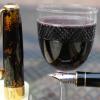
Antique Gold Pencil - Any Information?
PeterR-C posted a topic in It Writes, But It Is Not A Fountain Pen ....
I have been going through some old inherited stuff and have come across a pencil. It is a fine tube, with a slide that pushes out the lead - see photo. The lead is encased in wood, which is irregular and looks to have been whittled down from a larger pencil. A jeweller tells me that the thing is made of gold - no hallmark or stamp of any kind though - and that the jewel on the slide is a ruby, the one on the end a diamond. Can anyone tell me anything about this? When and where might it have been made? I had family members in India around 1910, and in the mid-19th century others travelled to Egypt. Could it be oriental? If anyone can tell me anything about its origins, or point me towards a source of information, I'd be very grateful. I know it's not a fountain pen, but the collective expertise of the people on the FPN is mind-boggling, so I figure someone might have some ideas. Peter -
Hello all, I came across this old, red, and anonymous pen at a flea market a while back. It caught my eye because of the bright color and unusual pattern on it. Ive seen plenty of marbled, striated, and pearlescent patterns, but Ive never seen one quite like this. It reminds me of vintage linoleum flooring. Unfortunately, there is no writing on it anywhere, save for the nib which is stamped (rather dubiously) Warranted 14K. Any ideas as to who the maker might be? Kind regards, Eric
-
Help: Trying To Figure Out This Pens Actual Name
AFountainPen34 posted a topic in Fountain & Dip Pens - First Stop
Can anyone help me I'm trying to figure out this pens brand and name. I found one similar on ebay but it just says "Mother of Pearl" but doesn't give me an actual brand or name. The nib is marked "WARRANTED 14K". Can anyone help?- 3 replies
-
- pen
- fountain pen
-
(and 7 more)
Tagged with:
-
Hi Fellow FP Addicts Welcome to Mega Group-Buy 2 of Ranga Pens This is an effort for Ranga Handmade Pens with Bock Nibs. For those who missed out on earlier group buys this is the right opportunity to buy various models from the past Groupbuy with the Bock nibs.. This Group Buy is Valid till 28-Feb-18 In order to participate in the group buy just fill the Google Form (Link Below) and Reply in the thread with "Form Submitted or just repost the choices in thread LINK: https://docs.google.com/forms/d/e/1FAIpQLScF0Hcwm7A8idJoGCfrj3av-c_QIdg6PLI1dWx8NBhnfNtLFQ/viewform?c=0&w=1&usp=mail_form_link MODELS: Different Models are available for this Group-Buy. The option of various models are as follows: Model 3 ( Previous Group-Buy Link: https://www.fountainpennetwork.com/forum/topic/315721-closed-ranga-model-3-and-3c-group-buy-dec-2016/?hl=ranga) Model 4 ( Previous Group-Buy Link: https://www.fountainpennetwork.com/forum/topic/320907-closed-ranga-model-4-and-4c-group-buy-april-2017/?hl=ranga) Model 5 ( Previous Group-Buy Link: https://www.fountainpennetwork.com/forum/topic/318187-closed-ranga-model-5-varuna-gajendra-group-buy-2017/?hl=ranga) Model 3C ( Previous Group-Buy Link:https://www.fountainpennetwork.com/forum/topic/315721-closed-ranga-model-3-and-3c-group-buy-dec-2016/?hl=ranga) Model 4C ( Previous Group-Buy Link: https://www.fountainpennetwork.com/forum/topic/320907-closed-ranga-model-4-and-4c-group-buy-april-2017/?hl=ranga ) NIBS: We(Ranga Pens) are providing the Bock Nibs in CC Mechanism for this Group-Buy as Second time. So for this group buy only Bock nibs will be available and the option for the nibs are as follows: #6 Steel Nib – Gold Monotone Finish: EF, F, M, B, 1.1, 1.5 #6 Steel Nib – Chrome Monotone Finish: EF, F, M, B, 1.1, 1.5 #6 Steel Nib – Dual Tone Finish: EF, F, M, B #6 Gold 18K Nib – F, M,B (@ extra US$ 185) Without Nib But Pen threaded to take Bock Nib (@ less US$ 14) MATERIAL & COLORS: Like the previous Group-Buys, both ebonite and acrylic are available in this group-buy. The various finishes available are as follows: Regular Ebonite: RE Series (Polished or Matte Finish) Solid Black Brown Ripple Olive Ripple Green Ripple Mottled Brown Mottled Olive Brown (Available for Model 3 ,4 , 3C, 4C Alone) Special Ebonite: SE Series (Has Black Specks) (Polished or Matte Finish) Solid Forest Green (Available for Model 3 ,4 , 3C, 4C Alone) Forest Green – Black Ripple Forest Green – Honey Ripple (Available for Model 3 ,4 , 3C, 4C Alone) Forest Green – Khaki Ripple Forest Green – Mustard Yellow Ripple Forest Green – Teal Blue Ripple Teal Blue – Black Ripple Teal Blue – Khaki Ripple (Available for Model 5 Alone) Mustard Yellow – Black Ripple Khaki – Black Ripple (Available for Model 3 ,4 , 3C, 4C Alone) Solid Cherry Red (Not Available) Rose Red – Black Ripple Rose Red – Mauve Ripple (Available for Model 3 ,4 ,5, 3C, 4C Alone) Rose Red – Blue Ripple (Not Available) Rose Red – Forest Green Ripple Rose Red – Bottle Green Ripple (Available for Model 5 Alone) Rose Red – Mustard Yellow Ripple Brick Red – Khaki Ripple Brick Red – Black Ripple Teal Blue – Orange Ripple Solid Bluish Green (Available for Model 5 Alone) Solid Crimson Red (Available for Model 5 Alone) Solid Olive Green Premium Ebonite: PE Series (Polished or Matte Finish) Solid Blue Black Yellow Swirl (Not Available) Blue Pink Swirl Solid Pale Green White Blue Swirl (Not Available) Pale Pink Black Swirl (Not Available) Green Yellow Swirl (Available for Model 5 Alone) Solid Pink Blue Green Orange Swirl (Not Available) Solid Orange Clear Acrylic Demonstrator: Brushed Clear Acrylic – Complete Brushed Clear Acrylic with Polished finial PRICE:The cost of the pen is at par with the earlier Group-Buys. And payment is accepted only via Paypal. Our Paypal id is mpkandan@gmail.com The price is as follows: Model 3 Regular / Special Ebonite: US $55 Premium Ebonite: US $70 Acrylic Demonstrator: US $62 Model 4 Regular / Special Ebonite: US $60 Premium Ebonite: US $75 Acrylic Demonstrator: US $67 Model 5 Regular / Special Ebonite: US $65 Premium Ebonite: US $85 Acrylic Demonstrator: :US $70 Model 3C Regular / Special Ebonite: US $55 Premium Ebonite : US $70 Acrylic Demonstrator : US $62 Model 4C Regular / Special Ebonite: US $60 Premium Ebonite : US $75 Acrylic Demonstrator : US $67 Shipping:Shipping period will be 4 to 5 weeks after payment via Registered Shipping. For Shipping within India kindly PM me In order to participate in the group buy just fill the Google Form (Link Below) and Reply in the thread with "Form Submitted or just repost the choices in thread
-

Best Fountain Pens Manufactured During Or Prior To 1920
Khranos posted a topic in Fountain & Dip Pens - First Stop
I've been collecting fountain pens for a while now, but my oldest pen is just a Parker 95 (manufactured in 1988, so just shy of 30 years old). I'm currently looking to vastly increase that number in hopes of owning a piece of early fountain pen history. The two pens I'm currently looking at are a Mabie Todd Swan (1884/1887(?) +) or a Waterman 52 (1915 +, so just barely applicable). From the research I've done, these two pens definitely stand out but it's by no means a conclusive decision. I'm looking for at least a few of the following qualities: Gold (tipped) NibAt least a semi-flex nib (as an available not-rare option)While capped, no smaller than ~5 inches or 15.5mmCan be found in working condition for under $200 USDReliable brand that doesn't require tons of maintenanceNot a dip pen (just don't have much use for one) I don't really care about the filling method, and the brand doesn't matter as long as it meets most of the criteria. I'm not very interested in sets so that doesn't affect my budget. A minor preference is that the pen was manufactured before 1914 to put it before WWI, but I know there was a "boom" of fountain pens during and just after the war that I wouldn't want to exclude for such a petty reason. I look forward to reading any suggestions! -
Hello my name is Barb McAllister and I am very new to this. My husband recently passed away leaving an extensive fountain pen collection. I am trying to identify some of the pens with the idea of selling them to someone who has the same passion as my late husband. If anyone can help with this endeavour, I would really appreciate it. Where do I start? Should I take pics of the pens and post them here?
-

Help Identify Or Get Information About A Old Bronze/brass/copper Inkwell
iznogood posted a topic in Paper and Pen Paraphernalia
Hello all! Hope I'm at the right place to ask this! If not please mods move this thread where it's supposed to be at! Well my sister is in Argentina for business and she just messaged me on facebook out of her mind with happiness. She found me a gift and could not resist sending me pictures. It's obviously a inkwell that seems to be made of either bronze, brass or copper. My sister said it's quite heavy but all those metals would be heavy at that thickness. She got it in a antique store I have nothing more. I checked ebay and did see a lot of similar inkwells often in pairs and almost always on some sort of marble or metal base. This one here has nothing else then the one inkwell. I'd love it if someone could either tell me what it is or point me to resources on inkwells so I can maybe have a chance of identifying this one. In any ways I cannot wait to get my hands on it. It's already beautiful but I bet a little light polish would bring it right back. Thanks in advance!! http://i.imgur.com/pRAqn6O.jpg?1 http://i.imgur.com/8swMSZT.jpg?2 http://i.imgur.com/0YIUIUJ.jpg?2 http://i.imgur.com/2AuXOB1.jpg?2 -
Just tested the 9 Antique colors from xFountainPens, including the latest Shamrock. The writing and scribbles are from a needle point Tachikawa 77 dip pen, so I can see it's much more of dusky purple to burgundy when laid on thick. The smears are a drop of ink on a metal needle, spread sideways to get an idea of the color at a "normal" ink density. The right end has a little thicker second small drop. Paper is HP 32# laser. No bleedthrough except the very-wet first letters drawn with the freshly loaded dip pen. I enjoyed the Shamrock in the Platinum 3776 F, and just switched to trying Jade Don't like it as much. I don't like light, unsaturated (color, not chemically) inks so much. Dark unsaturated is OK.. Jade looks grey as Slate going on, but quickly dries to the final greenish color. Darkness stays the same, around 50% of black by rough guess. The Raspberry isn't very red unless laid on thick. It's more of a more of a terra-cotta or dilute dusky purple. My favorite are Oxford and maybe Yankee. I love intense colors. I don't even mind lower saturation color-black looking mixes, but I don't like washed out. Orchid has possibilities. Scarlet is a nice red, but I have a lot of red inks. These are maybe best in pens (popular on here) with more flow, robably great for a wet stub or broad. My 3776 has a fine that I'd call quite juicy, a little wetter than I generally go for, and it's not ideal for most of these. You'd; be right to question my wisdom buying "Antique" colors, given that preference. I'll try them in turn, properly, in the Platinum pen, and maybe tweak a hue if it doesn't grow on me. Jade is loaded now, and to me begs for a 20-40% addition of something like Sheaffer's teal-ish green. I take pride in not being a slave to the (ink) bottle if I want a little more punch or a slight color shift, before giving up. Another option happens all the time in weeks or months in most pens, but won't in the slip-and-seal 3776 - let the ink partially dry out. I may put 1mL of the Jade in a 5mL vial with the cap loose, and reload the pen when it evaporates down to about half a mL. I might really like that color. Typically I use noodlers inks and it goes the other way (dilute about 50%), which has the benefit of being quicker. The biggest win for me is Oxford. It has sheen, it's a brilliant not-greenish blue, and is my concept of the vaunted Majestic Blue, improved. It's cheaper than Diamine Blue velvet, not sure which I'll prefer. For intensity I think BV may win. Oxford is more interesting. Majestic Blue itself, compared to either, is disappointingly leaning teal, unless I got bad samples. I had someone else say Raspberry gives excellent shading, so take that as you will. I consider shading generally a negative characteristic, and also blaspheme by believing that "lubrication" is not an attribute distinct from how wet the nib is at the paper while writing (i.e., flow rate minus paper absorption rate). This test method doesn't let me judge much about those ancillary factors. I really just want to know color hue, and does it look OK with a middling to dry EF to F nib.
- 4 replies
-
- chesterfield
- antique
-
(and 2 more)
Tagged with:
-
Hello all I am new to the forums. I have an antique Mabie Todd dip pen and would like to find other nibs that fit the pen. The Mabie Todd nib that is currently in the pen is expensive and difficult to find. I would like to write with the pen a lot but all the nibs I have don't fit this pen. I recall seeing another post on the forums discussing nib and holder matching. The posted stated that Victorian dip pens had smaller nibs. If anyone could suggest a nib that would fit the pen I'd really appreciate it. I have attached a picture of the pen/nib you should be able to see the nib if you zoom in. Thanks in advance.
-
- mabie todd
- dip pen
-
(and 3 more)
Tagged with:
-
Check this out! Someone on Facebook shared this video, and my jaw dropped. Imagine all the ink and pens you could hide away in this lovely, lovely secretary cabinet. http://themetapicture.com/this-antique-cabinet/ Hopefully, this is the appropriate place to post such greatness and ingenuity.
-
I recently purchased a black chased hard rubber pen on eBay, with the only markings being an imprint of a soldier on the cap, and "Cadet 14K 2 S" on the nib to give any indication of what make or model it might be. I've been trying to research Cadet, and have turned up nothing but Sheaffers (which this pen is decidedly NOT) and Summit, perhaps? It's a really nice pen, great writer with great flex, and much cleaner now than the listing photos I'm sharing. I'm just befuddled by the lack of information. And hoping that someone more knowledgeable of pen history might be able to shed some light on this little guy! The listing: http://www.ebay.com/itm/400765394859?_trksid=p2059210.m2749.l2649&ssPageName=STRK%3AMEBIDX%3AIT A couple listing photos: http://i.ebayimg.com/00/s/OTU4WDExMjM=/z/d-AAAOSwDk5UAPOo/$_57.JPG http://i.ebayimg.com/00/s/MTIwMFgxNjAw/z/1ksAAOSw-jhUAPPH/$_57.JPG?rt=nc
-
Questions About Antique Dip Pen
curiousbibliophile posted a topic in Fountain & Dip Pens - First Stop
Hi, I'm new to using fountain and dip pens, but they've always sounded really cool. When I saw a dip pen at an antique store last month, I ended up coming home with it. I would really appreciate any information you may know about it! On the back of the nib it says: A Edward Todd & Co New York 2 It has a mother of pearl handle, and yellow metal. Even if you don't have much information about it, I have some specific questions: 1. Does the nib part look too long? Photos I've seen of pens similar to this one (I haven't seen any exactly like it) seem to have shorter nibs. 2. What type of writing is it probably meant for? 3. What should I soak the metal part in to be able to separate the nib without breaking it? 4. What size nib is it? 5. (May mean the same thing as 3) What do I use to clean it? Thanks! -
Hello there, I have had a bit of bad luck lately with a couple of antiqe waterman's that I recently acquired. Both pens have started leaking inside the cap to the point that ink gets everywhere and even down onto the section. On close inspection I can see that the inner cap on both pens is distorted. So the inner cap is no longer round and doesn't seal properly and on both pens I can see a spot where the inner cap has pulled away from the wall of the outer pen cap. Both pens are BHR from the 1920s does anyone have any experience with this problem and ways of fixing it? Thanks. scribe16
-
Hello FPN people, I have had a bit of bad luck lately with a couple of antiqe waterman's that I recently acquired. Both pens have started leaking inside the cap to the point that ink gets everywhere and even down onto the section. On close inspection I can see that the inner cap on both pens is distorted. So the inner cap is no longer round and doesn't seal properly and on both pens I can see a spot where the inner cap has pulled away from the wall of the outer pen cap. Both pens are BHR from the 1920s does anyone have any experience with this problem and ways of fixing it? Thanks. scribe16
-
- watermanwatermans
- vintage
-
(and 5 more)
Tagged with:
-

What Happened To Handwriting?
GabrielleDuVent posted a topic in Handwriting & Handwriting Improvement
Recently I've been getting/seeing notes from whom I assume to be quite elderly people (I assume that simply because they're 'thank you for buying' notes from online antique vendors). I've gathered quite a collection of them, and the beauty of their handwriting - no doubt quickly written, most often with regular ballpoints or even pencils - amaze me. Then I remember the handwriting of my peers and they have the grace of Twilight prose in comparison to Evelyn Waugh. Did people from the 1960s and beyond have more writing under their belt? But I remember doing quite a lot of writing myself as a schoolgirl, as typed material weren't allowed until university. Penmanship classes? But I had them too. Fountain pens...? They're just pens, it's not like they magically transform handwriting. In all my (scant) years, I haven't actually seen handwriting from any of my peers that made me say, "wow, that is beautiful" (it's mostly 'this is illegible, I don't think this is in any known alphabet'). But I see them all the time amongst the antique vendors. Does anyone know the reason why? Do antique vendors just all have beautiful handwriting...? Or is this a generation thing?












